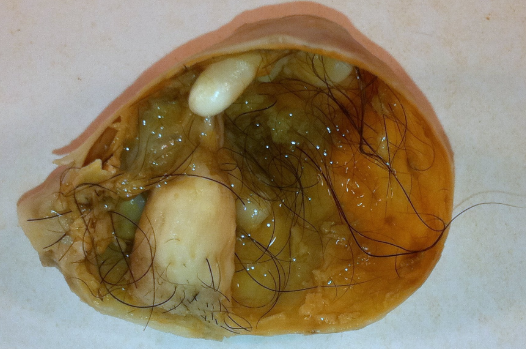Imagine a tumor that doesn’t just grow—but grows teeth, hair, or even fragments of bone. As strange as it sounds, this isn’t the plot of a sci-fi film—it’s a real medical phenomenon known as a teratoma. Derived from the Greek word “teras,” meaning monster, teratomas are among the most unusual tumors ever discovered in human biology. Found in both children and adults, and capable of appearing in various parts of the body, these growths are not just medically significant—they’re a curious blend of embryology gone awry and cellular potential gone rogue. In this article, we’ll explore what teratomas are, how they form, where they’re found, and why they continue to intrigue both scientists and doctors alike.
What Exactly Is a Teratoma?
A teratoma is a rare type of tumor that arises from germ cells—the same cells that form eggs or sperm. Teratomas stand out because they can produce a variety of tissue types, including skin, hair, fat, muscle, cartilage, teeth, and even nervous tissue, all within a single mass. Germ cells enable this because they possess pluripotency, allowing them to transform into any cell type in the human body.
Unlike most tumors that contain only one kind of abnormal tissue, teratomas create a patchwork of different, often unrelated structures. This unusual composition attracts both medical curiosity and scientific research. While doctors classify many teratomas as benign, some exhibit malignant behavior and demand prompt medical intervention.
In essence, teratomas result from developmental confusion—when the body’s foundational cells mistakenly build a disorganized mix of tissues in abnormal locations.
Where Do Teratomas Occur?
Teratomas can form in various parts of the body, depending on where germ cells migrate during early embryonic development. The most common sites include the ovaries, testes, and tailbone region, but they can also appear in more unusual locations.
- Ovaries (in females): Ovarian teratomas are among the most frequently diagnosed and are often benign. These are commonly referred to as dermoid cysts and may contain hair, teeth, or skin.
- Testes (in males): Testicular teratomas typically occur in young men and can be either benign or malignant, especially in adults. They are part of the broader category of testicular germ cell tumors.
- Sacrococcygeal region (in infants): This is the most common site for teratomas in newborns, especially females. Known as sacrococcygeal teratomas, these tumors develop at the base of the spine and are usually diagnosed at or shortly after birth.
- Mediastinum: Teratomas can occasionally occur in the chest, near the heart and lungs. These are called mediastinal teratomas and may present with chest pain or breathing difficulties.
- Brain and other rare sites: In extremely rare cases, teratomas have been found in the intracranial region, neck, or abdomen, sometimes causing pressure on nearby organs or tissues.
Though teratomas can appear in many areas, their behavior—whether benign or malignant—largely depends on location, age of the patient, and histological composition. Early detection and appropriate treatment are key to managing their outcomes effectively.
Types of Teratomas
Medical professionals classify teratomas based on how developed their tissues are and whether they can become cancerous. The most commonly seen type, the mature teratoma, contains fully developed, well-differentiated tissues such as skin, hair, fat, and occasionally teeth or bone. These tumors usually grow in the ovaries, where doctors often refer to them as dermoid cysts. Surgeons typically remove mature teratomas with excellent outcomes, as these tumors are usually benign.
On the other hand, immature teratomas include underdeveloped, embryonic-like tissues and present a higher risk of malignancy. These tumors tend to behave more aggressively and often require both surgical removal and chemotherapy, particularly when pathologists identify malignant features. Immature teratomas can develop in the ovaries, testes, or brain, making early detection and diagnosis critical for successful treatment.
In rare cases, patients develop monodermal teratomas, which contain primarily one type of specialized tissue. One well-known example is struma ovarii, a tumor made up mostly of thyroid tissue, which can sometimes trigger hyperthyroidism. Although these tumors usually remain benign, doctors may need to monitor them closely after surgery due to their unpredictable behavior.
By identifying and understanding the different types of teratomas, healthcare providers can make more accurate diagnoses, choose the right treatments, and ensure proper follow-up care, especially since the behavior of these tumors depends heavily on their maturity and location.
Bizarre But Real: What’s Inside a Teratoma?
One of the most astonishing features of teratomas lies in what they contain. Unlike typical tumors, which grow as uniform masses of abnormal cells, teratomas display a chaotic mix of recognizable body parts in the most unexpected combinations. These tumors often produce fully developed teeth, strands or clumps of hair, fat pockets, bone fragments, cartilage, and even muscle tissue. In rare instances, they generate more complex and organized structures, such as eyeball-like formations, intestinal loops, or brain-like tissue.
Pluripotent germ cells—cells with the ability to become any tissue in the human body—give rise to this bizarre phenomenon. When these cells follow abnormal developmental paths, they differentiate into multiple tissue types, creating a miniature, disorganized collage of body parts within a single tumor.
Although these internal contents appear startling, they remain non-functional and form randomly. They do not act as real organs or living systems. Nonetheless, the presence of such diverse and misplaced tissues continues to capture both medical and public fascination. For many, imagining a tumor that grows hair or teeth inside the body feels eerie yet awe-inspiring. But in the case of teratomas, this biological oddity doesn’t just exist—it occurs more often than one might expect.
Are Teratomas Dangerous?
The risk a teratoma poses depends largely on its type, location, and whether it shows malignant characteristics. Mature teratomas usually grow slowly and remain benign, especially when they develop in the ovaries. Surgeons can often remove them completely, and patients typically recover well with an excellent prognosis.
However, immature teratomas behave differently. These tumors contain less-developed, embryonic-like tissue and often grow rapidly. They can invade nearby structures and spread to other parts of the body. In such cases, doctors must treat them aggressively, combining surgery with chemotherapy to prevent further complications.
Even mature teratomas can become dangerous under certain conditions. When they grow large enough, they may compress nearby organs or vital structures. For instance, a teratoma that develops in the brain or mediastinum (the central chest area) can exert pressure that causes serious symptoms. Additionally, in rare instances, teratomas may undergo malignant transformation, where they evolve into other types of cancer.
To assess the risk, doctors rely on early detection, imaging techniques, and histological evaluation. While many teratomas remain curable and pose little long-term danger, others demand careful follow-up and intensive care. Their unpredictable behavior requires medical teams to take every case seriously, regardless of initial appearance.
The Science and Mystery Behind It
Teratomas sit at a fascinating intersection of embryology, oncology, and stem cell science. What makes them so extraordinary is their origin from pluripotent germ cells—the very building blocks capable of forming any tissue type in the human body. Under normal circumstances, these cells go on to develop into highly specialized tissues during fetal development. But in the case of a teratoma, something goes awry. Instead of following a structured developmental pathway, these cells grow in a disorganized and often chaotic manner, giving rise to a tumor that may contain hair, muscle, fat, or even neural elements all jumbled together.
Beyond clinical diagnosis, teratomas have a profound role in scientific research. In the field of stem cell biology, scientists often use teratoma formation as a test for pluripotency. When human embryonic stem cells or induced pluripotent stem cells are injected into animals, the development of a teratoma confirms that these cells have the ability to differentiate into multiple tissue types. In this context, the teratoma becomes a biological indicator of cellular potential—a paradoxical fusion of medical anomaly and scientific tool.
Despite decades of study, many aspects of teratoma development remain a mystery. Why do some teratomas remain benign while others turn malignant? Why do certain tissues form more commonly than others? These unanswered questions continue to intrigue researchers, making the teratoma not just a bizarre medical case but a key to understanding deeper truths about human development and cellular behavior.
Final Thoughts
Teratomas are a remarkable blend of science, mystery, and medical anomaly. From their bizarre internal structures to their roots in pluripotent germ cells, these tumors challenge our understanding of how the human body develops—and how it can sometimes go wildly off course. While many teratomas are benign and treatable, others require urgent medical attention due to their potential for malignancy or pressure on surrounding organs.
Beyond their clinical significance, teratomas continue to captivate researchers and the public alike for their strange yet fascinating nature. They remind us that the body, in all its complexity, holds countless surprises—some unsettling, others enlightening. Whether encountered in a surgical theater or a stem cell laboratory, teratomas are a vivid example of biology’s power, unpredictability, and enduring mystery.




